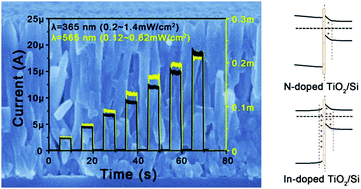Enhanced UV-visible light photodetectors with a TiO2/Si heterojunction using band engineering†
Abstract
A simple hydrothermal process involving thermal diffusion has been developed to synthesize almost vertical doped titanium dioxide (TiO2) nanorod arrays on a silicon (Si) surface. The enhanced ultraviolet-visible (UV-vis) light photodetectors with a TiO2/Si heterojunction were fabricated using band engineering, by doping indium (In) or nitrogen (N) in TiO2 nanorod arrays. The photodiodes showed high quantum efficiencies of 200–400% under visible light illumination (e.g., 565 nm), and ∼16% with UV light (365 nm). Additionally, the N-doped TiO2/Si devices, with a unilateral linearly graded junction, had greater rectification characteristics, lower dark current, better quantum efficiency and response to UV detection, and the In-doped TiO2/Si heterojunction had a better multiplication factor for weak visible light detection, with a decreased electronic barrier and increased carrier concentration. These excellent results mean that doped TiO2/Si heterojunctions will be useful for new UV-vis light detection enhanced photodiodes which do not require expensive auxiliary equipment, thus making them easy to use in applications involving portable and wearable equipment.



 Please wait while we load your content...
Please wait while we load your content...